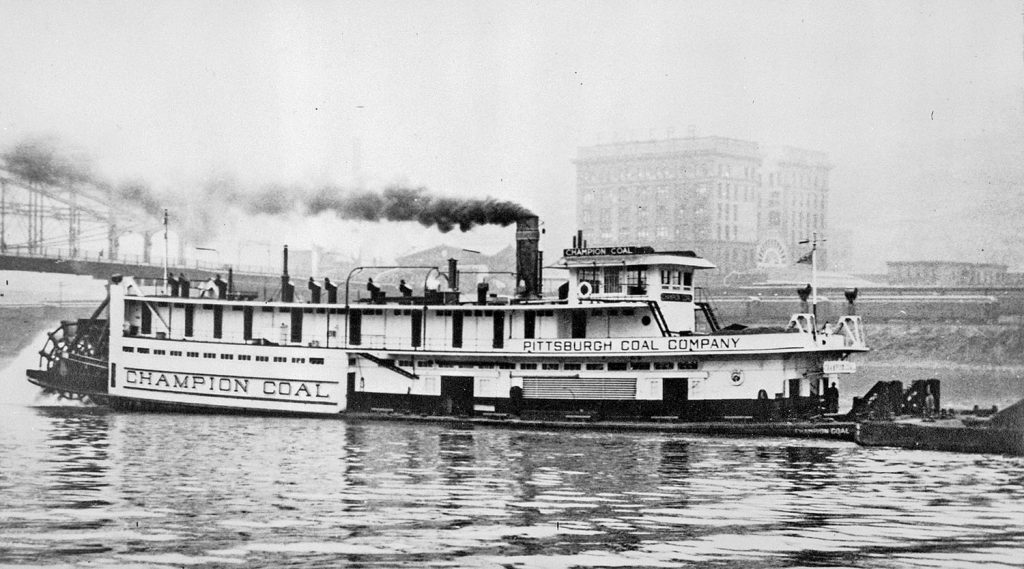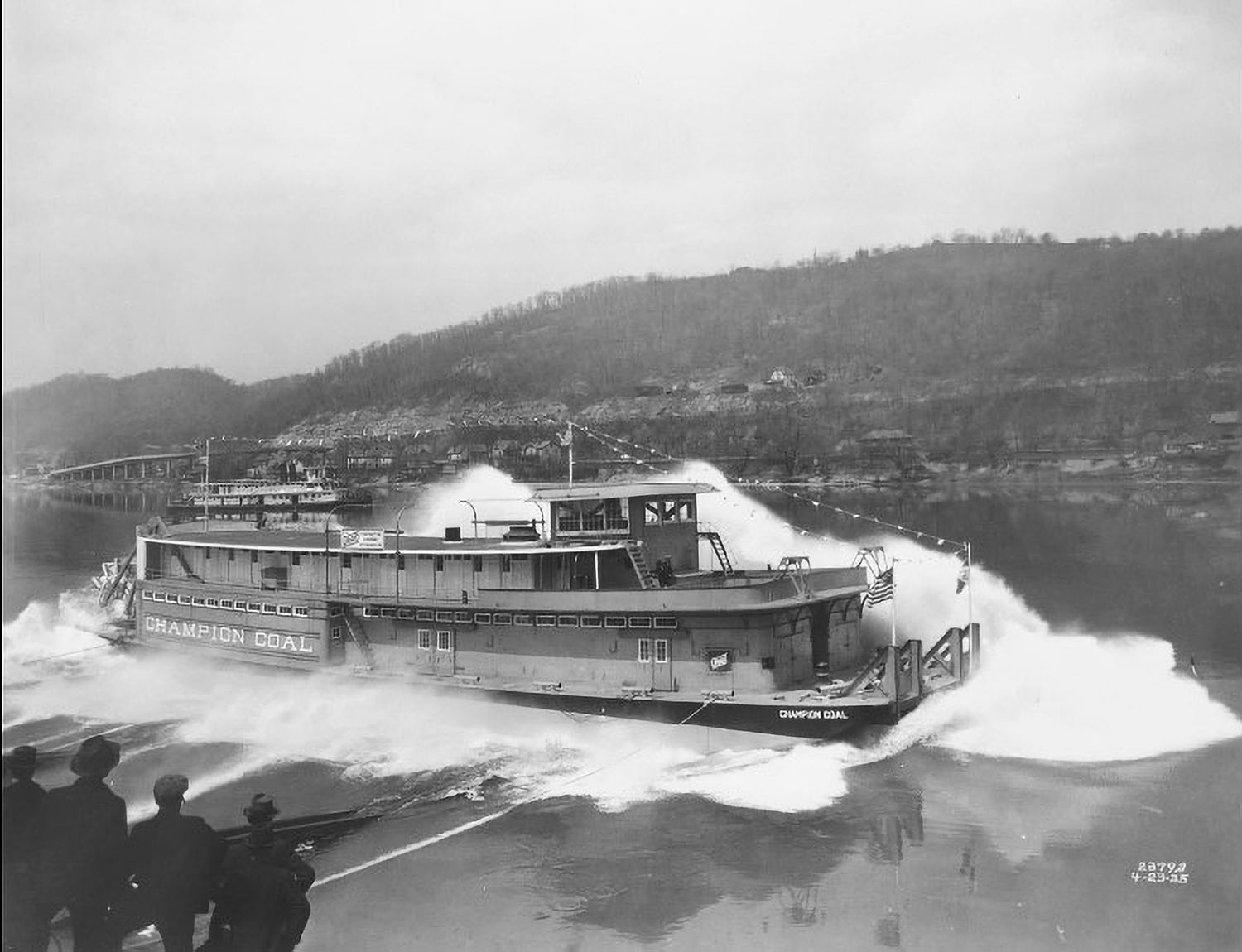The Western Rivers towing industry was seeing much change in the year 1935. The Inland Waterways Corporation, the government-owned towing concern nicknamed the Federal Barge Line by rivermen, had been experimenting heavily with prop towboats built with tunnel sterns since 1920. Within recent years, the IWC had been building some large propeller-driven craft powered with diesel engines, rather than steam. In 1934 and 1935, Union Barge Line had the Dravo Corporation build the Peace and Neville, “ultra-modern” diesel prop boats for their fleet, which until this time had been exclusively steam sternwheel. The new Mississippi Valley Barge Line had built four large steam-prop towboats, and the Jones & Laughlin Steel Corporation of Pittsburgh had built two steam prop boats at Ward Engineering in 1931 to be utilized in delivering steel products to Memphis.
However, steam sternwheel was still the predominant means of propulsion for most large towboats. Particularly in the Pittsburgh area, it seemed that operators were reluctant to embrace the new propeller vessels. The shallow Monongahela River at the time may have been considered better suited to the traditional sternwheel construction. Sternwheel steamboats would continue to be built for these trades over the next several years. During World War II, most new construction went toward military vessels for the war effort, and it would not be until the early 1950s that the steam sternwheel boats began to be retired in favor of diesel prop towboats.
The June 8, 1935, issue of The Waterways Journal had a large feature story regarding a brand-new steam sternwheel towboat just entering service for the Pittsburgh Coal Company. Named Champion Coal, the boat had been built by the Dravo Corporation at their Neville Island, Pa., shipyard. According to the article in the WJ, the contract had been signed on October 4, 1934, with the keel laid on January 7, 1935, vessel launch on April 23 and delivery to the owners on June 3. The designer of the new boat was Thomas Rees Tarn, a celebrated naval architect of Pittsburgh.
The Champion Coal had a hull “constructed of genuine wrought iron shell plates,” to combat corrosion, and it was 148 feet by 34 feet with an overall vessel length of 174 feet. The Nordberg “high efficiency” condensing engines were 16’s, 30’s – 7-foot stroke, rated at 800 hp. The sternwheel was 21 feet in diameter and 22 feet wide. It was equipped with a coal burning Foster-Wheeler steam generator with a Standard automatic stoker and “Shear-Klean” shaker grate. The steam generator allowed for the placement of a single smokestack behind the pilothouse. The boat could carry 40 tons of coal in bunkers, plus an additional 15 tons on the boiler deck. Gross tonnage was listed at 449 with net tonnage at 291. The new boat was of metal construction with the exception of the upper cabin aft of the pilothouse, and that was of traditional wooden construction.
An open house and three-hour “maiden trip” cruise and luncheon for invited guests was held at Pittsburgh on June 4, 1935. In a separate story by George A. Zerr in the June 8 issue, it was noted that the Champion Coal was towing an excursion barge owned by the Carnegie Steel Company on the cruise, and that area vessels were saluting the new boat with their whistles, as did some passing trains. Zerr also stated that the new boat had been built at a cost of “more than $260,000.” That would be roughly $5.7 million in 2023 dollars. This same issue carried a host of ads from suppliers of equipment for the Champion Coal, including the Nordberg Manufacturing Company, Foster-Wheeler, Shear-Klean Grate Company and American Machine & Engineering, which had supplied the capstans. Dravo had a full-page ad featuring a photo of the vessel launch. In the background was the new diesel prop Neville of Union Barge Line, a glimpse into the future of river transportation, waiting to retrieve the new sternwheel boat.

Following the festivities at Pittsburgh, the Champion Coal officially entered service as the flagship of the Pittsburgh Coal fleet. The crew aboard as it began the first trip were Capt. William I. Shaw, master; Capt. A.S. Hendrickson, pilot; John Bush, chief engineer; John Kyle, assistant engineer; and mates C.E. Miller and Ed Miller. Ways Steam Towboat Directory notes that the Champion Coal spent its career working between the Mon River mines and Weirton Steel at Weirton, W.Va., Mile 62 Ohio River. Pittsburgh Coal Company later became the Pittsburgh Consolidation Coal Company, then the Consolidation Coal Company, and then simply Consol. The Champion Coal was laid up in 1951 when three new 1,066 hp. diesel boats were built for the concern by Dravo—the Arkwright, Mathies and R.L. Ireland.
In 1954 the Champion Coal was dismantled. Heralded in 1935 as “a milestone in engineering for the production of a modern and efficient coal burning, steam, sternwheel towboat for Pittsburgh’s ‘pool’ service,” it had an actual running career of only some 16 years. The three diesel boats built in 1951 are still in operation today for American Consolidated Natural Resources Inc., which can trace its roots back to Consol. The name Champion Coal returned to the rivers in 2006 when Capt. Mike Somales, then the head of River Transportation for Consol, convinced the company to place that name on the recently acquired Lillian G. However, Consol was sold to Murray Energy in 2013, and the boat was renamed in 2014, leaving the rivers without a Champion Coal once again.



